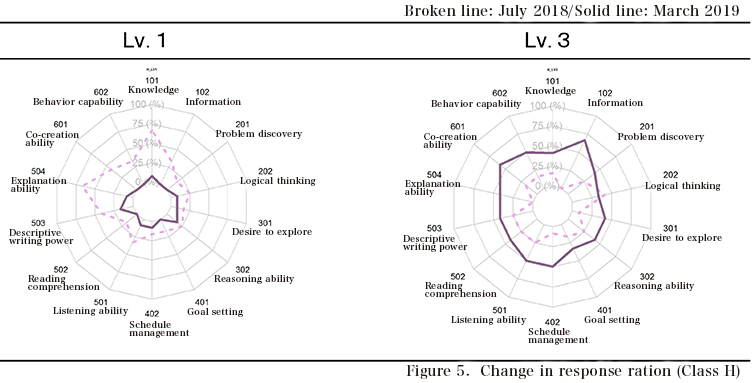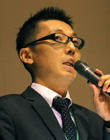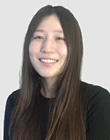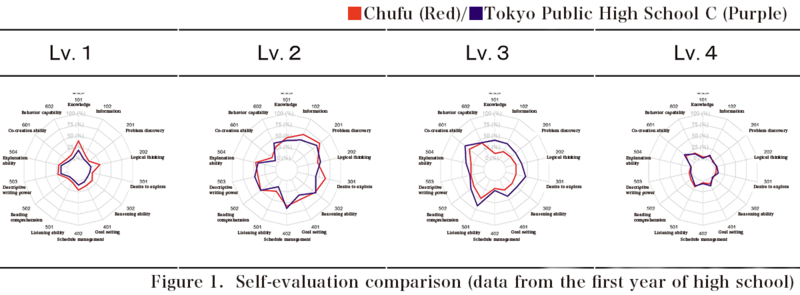Nurturing "Knowledge into Action"
~Competency Analysis Based on the Results Obtained from the Self-Evaluation Questionnaire Vol. 2~
Yu Saito/Teacher of Japanese language, Chuo University Junior and Senior High School at the Koganei campus
Yoko Neha/Teacher of Information Technology, Chuo University Junior and Senior High School at the Koganei campus
Second year as an SSH (Super Science High School)
In addition to the improvement of academic ability, another challenge in future education is to further develop the ability to apply knowledge and turn it into action. Accordingly, we should strive to foster the ability to apply knowledge into practice. These goals must be addressed by Chuo University and its affiliated schools, which promote the universal message of "knowledge into action".
During the first year of our application for the status of a SSH during the 2018 academic year, the Chuo University Junior and Senior High School (hereinafter, "Chufu") created Chufu Compass, a self-evaluation questionnaire that measures the competency of high school students (focusing on behavioral characteristics as a manifestation of attributes and abilities), linked the resulting answers to the learner group, and conducted an analysis 1. This article introduces the results of the second (and subsequent questionnaires) conducted in 2019 and discusses some of the new challenges faced.
1 Saito & Neha (2019), How Can We Measure Learning Ability? ― Analysis of a Competency Self-Assessment Questionnaire ―
https://yab.yomiuri.co.jp/adv/chuo/dy/education/20190322.html
Items clarified by the questionnaire
(1) Comparison with other schools
In the first questionnaire administered in the 2018 academic year, based on a comparison with two cooperating schools (Tokyo Public High Schools A and B), we formed a hypothesis that it is possible to extract items which are generally difficult for high school students. In the 2019 academic year, with the cooperation of another SSH (Tokyo Public High School C), we compared the answers regarding competency and self-evaluation at the time of entering high school between their students and the students at Chufu. In the following figure (Figure 1), the origin is in the center and the axes representing the response ratio for each item are set from the centre outward. Level 1 to Level 4 are the behavior characteristic levels; specifically, Level 1 represents problematic behavior, Level 2 represents behavior while awaiting instructions, Level 3 represents voluntary behavior, and Level 4 represents autonomous behavior.
Looking at the overall shape of Level 1 and Level 3, the Chufu (Red) response ratio for Level 1 (problematic behavior) was somewhat larger than that of Tokyo Public High School C, while the Tokyo Public High School C (Purple) response ratio for Level 3 (voluntary behavior) was larger than that of Chufu. For example, in Category 101 "Knowledge," 18.5% of students at Tokyo Public High School C selected Level 1 "(1) I consider my knowledge to be insufficient even in a certain field," while 39.3% of Chufu students selected Level 1. In other words, the competency self-evaluation of Chufu students in the first year of high school is relatively lower than that of Tokyo Public High School C. In this regard, the potential to improve this situation exists in the Comprehensive Liberal Arts I course, a school-designed course that is intended for second-year high school students that started from the 2018 academic year.
(2) Response ratio by classes in Comprehensive Liberal Arts I
We linked the Chufu Compass response results (two times) from the 2018 academic year and the names of students who selected the Comprehensive Liberal Arts I course (total 12 classes), and then extracted by class the Categories. where the responses for Level 3 (voluntary behavior) and Level 4 (autonomous behavior) increased by a margin of 10% or more. In this article, we will discuss two of these classes.
In Class B "Training Science" (Japan Institute of Sports Sciences and others; class size of 26 students), the class uses an academic perspective to examine aspects of the human body; for example, the physiology of exercise, functional anatomy, and training science. Additionally, during a research trip held in October, students visited research facilities in the Tokyo metropolitan area and conducted field surveys at various training sites.

Noteworthy points for Class B are as follows: there was a 13.2% increase for Item 201 regarding "Problem recognition" Level 4 = "(4) In addition to the assigned problems, I am also able to set new problems by myself," and there was a 13.6% increase for Item 302 "Reasoning skills" Level 4 = "(4) I continuously strive to improve the certainty of the hypothesis by measuring the factors and the regularity of events." Due to these two items, Level 4 positive responses increased by more than 10%. (See Figures 2 - 4)
Furthermore, there was a 22.3% increase in Item 503 "Descriptive writing skills" Level 3 = "(3) I consider myself capable of writing a series of correct sentences so that others can understand the full extent of my writing." As a result, the median value shifted from Level 2 to Level 3. When considering Item 503 "Descriptive writing skills" Level 2 = "(2) I consider myself capable of writing coherent sentences to the greatest extent of my ability," the highest ratio of students are now conscious of others during their writing, as evidenced by the shift from "to the greatest extent of my ability" to "others can understand the full extent...."
In Class H, where they are focusing on "Learning from Disasters: Disaster Prevention and Support That We Can Provide (Minami-Soma City, Fukushima Prefecture: 13 people)." This class is held to study the current conditions of disasters and initiatives for reconstruction while examining disasters which have occured frequently in Japan in recent years, including the Great Hanshin-Awaji Earthquake, the Great East Japan Earthquake, and the Great Kumamoto Earthquake. During the research trip held in October, students visited Minami-Soma City in Fukushima Prefecture to learn about challenges related to reconstruction and their progress, to identify the challenges that need to be dealt with in the future, and to consider how we can provide further assistance for people living outside the disaster area.

The reason we wanted to introduce the results obtained from this class, was because the second Chufu Compass changed significantly among the 12 courses from the 2018 academic year. Among all of the 14 courses in Chufu Compass, 13 courses changed by 10% or more, 3 courses changed by 40% or more, and 1 course changed by more than 60%.
The specific breakdown is as follows: Item 102 "Information" Level 3 = "(3) I am able to notice the need for information and gather the necessary information" increased by 66.7%, Item 402 "Self-management" Level 3 = "(3) I manage the schedule based on the plan and am able to perform periodic checks" increased by 41.7%, Item 504 "ability Creative expression" Level 3 = "(3) I believe that I am able to provide fairly easy-to-understand explanations to other people" increased by 41.7%, Item 601 "Co-creation ability Teamwork (skills)" Level 3 = "(3) When working as a team, I try to understand the common goals of the team" increased by 41.6%, and Item 602 "Activeness" Level 3 = "(3) I believe that I act based on my own will and judgment" increased by 33.3%.
Of course, even when considering that a proportion of respondents are prone to change due to the large number of students selecting classes, the results highlight the extent to which this course stimulated the intellect and behavior of the students.
With regards to the Comprehensive Liberal Arts I course, it is inevitable that classes planning research trips to overseas destinations become popular. Amidst such conditions, some students who selected to join Class H have stated that they did so against their own wishes. Even so, we must recognize the fact that Class H has a large impact on students' competency self-evaluation.
In other words, based on competency self-evaluation of students in Class H "Learning from Disasters: Disaster Prevention and Support That We Can Provide," we can see the important truth that even if the training site is not based overseas, and even if the results of class selection is are not necessarily in line with the student's wishes, special techniques of teaching make it possible to influence the ability of students willingness to learn and change the self-evaluation of their own attributes and abilities.
Evaluation for improving the quality of learning
Just as student self-evaluation is not all about evaluation alone, valuation and ranking by grades is just one aspect of evaluation. Grading at the end of a unit or semester is not the same as evaluation that is intended to support the learning process and encourage further learning. Therefore, it is necessary to focus on evaluation as feedback. Statements such as the following can be seen in the recollections of faculty members in charge of the Comprehensive Liberal Arts I course.
Q While teaching the class, at what moment were you first aware that the students were enjoying the learning process? the joy of learning on your students' faces?
A When giving an oral examination during the first semester, I could see joy on the faces of students who were able to display the results which they had worked hard to achieve. When presenting a book review during the third semester, students who gave outstanding presentations received recognition and praise. Both students who praised others and the students who garnered the praise. (Class J)
As mentioned above, the experience of recognizing one's own efforts and receiving praise for one's own achievements is a valuable form of "evaluation as feedback" for the students themselves. This in itself is sufficient as evaluation. By being present during such occasions, faculty members can feel confident about the structure of the learning process and begin to consider ways to elicit further learning.
Through evaluation, learners can look back on the learning process and have an outlook regarding their further personal growth and development. Accordingly, evaluation must function by having learners themselves design their own learning processes in order to achieve qualitatively desirable changes.
Aspirations for the future
From the results measured from the Chufu-compass, we realize the need to further encourage students to engage in metacognition regarding their observations in the learning process. Also, with regards to cognition, we need to encourage faculty members who serve as teachers to acquire guidelines for how to improve their instructions. Faculty staff should aim to integrate diagnostic, formative, and comprehensive evaluation, and should work to shift from evaluation as valuation to evaluation as support (assessment). On the frontline of education, together with interested parties such as students and faculty members, we will continue to consider the appropriate form of evaluation for improving the overall quality of learning for students.
Reference literature
◆Visible Learning: A Synthesis of Over 800 Meta-Analyses Relating to Achievement, John Hattie (translated by Koyo Yamamori), Toshobunka, 2018
◆Evaluation Changes and Classrooms are Changed: Curriculum Management and Evaluation as Assessment for Developing Attributes and Abilities, Nobuo Takagi, Sanseido Bookstore, 2019
◆Skills for Social Progress: The Power of Social and Emotional Skills, Organisation for Economic Co-operation and Development (OECD), written and edited by Takashi Muto and translated by Kiyomi Akita, Akashi Shoten, 2018
◆The Essence of Connecting High Schools and Universities: Issues Clarified from the "Survey on Connecting Schools and Societies," Shinichi Mizokami (Chief Editor), Center for the Promotion of Excellence in Higher Education of Kyoto University, Kawaijuku Educational Institution (Editor), Gakuji Shuppan, 2018
Yu Saito/Teacher of Japanese language, Chuo University Junior and Senior High School at the Koganei campus
Yu Saito graduated from the Faculty of Education, Tokyo Gakugei University.
In 2005, he was appointed as teacher at Chuo University Suginami High School.
He assumed his current position in 2018.
Research themes: Japanese language education and competency development. For the research discussed in this article, he devised questionnaire items and decided on analysis policy.
Yoko Neha/Teacher of Information Technology, Chuo University Junior and Senior High School at the Koganei campus
She graduated from the Faculty of Engineering at the Musashi Institute of Technology (currently Tokyo City University).
Research themes: Information education and math/science education. For the research discussed in this article, she proposed analysis methods and oversaw analysis work.









